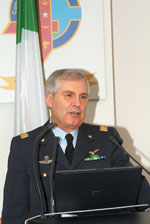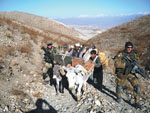Italy Grapples With Internal, External Transformation
 |
| Lt. Gen. Pietro Finocchio, ITAF, is the general director of Italy’s General Directorate for Information Technology and High Technology. |
The Italian military is encountering its own challenges as it moves from information silos to network centricity. Its armed forces are undergoing a transformation similar to that of other Western militaries in the transition from a post-Cold-War structure to one better suited for the Global War on Terrorism.
Lt. Gen. Pietro Finocchio, ITAF, is the general director of
At the heart of this transformation is a shift away from telecommunications platforms to an interconnected global network. Without it, the military cannot function in the post-Cold-War environment. As a linchpin of the Free World,
And, the enemy cannot be identified with a specific geographical location. Adversaries could be anywhere in the world, including within
This does not mean that
Gen. Finocchio describes a future in which platforms are lighter but networked. They will not carry all the sensors that they might possibly need for a mission, but they will be able to share operational information with other platforms that bear the sensor needed for a type of data.
The general relates that Italian forces already are able to achieve this for some specific geographic areas, especially with advance notice such as for planned special events. But
As with other high-technology forces,
New waveforms might be especially useful in satellite communications, Gen. Finocchio offers. Instead of engineers being locked into designing a satellite’s communications capabilities many years before its use would end, equipping a satellite with software-defined transceivers would allow it to be upgraded from the ground while in orbit.
Satellites will play a big role in
“From a single satellite service, we now are moving toward a constellation of satellites that are complementary to ensure continued services,” the general points out.
But simply upgrading communications satellites is not
While it currently must rely on other space organizations to launch its satellites,
For networking, the new IPv6 Internet protocol will allow giving priority directly to the information for distribution. It will enable nodes of communication that are not located regionally, which likely will define future military operations.
Gen. Finocchio explains that this architecture must be flexible and comprise several different interconnected layers. This would permit connectivity anywhere, anytime. He describes “bricks” of hardware, software and services building this architecture across operational communities. It would be a service-oriented architecture that would be adjusted to suit user needs as required.
This architecture will take considerable time to develop, Gen. Finocchio cautions. “
NATO standards are providing the building blocks of this architecture, the general adds. “We must be interoperable with NATO,” he declares.
 |
| Italian troops in Afghanistan escort an aid convoy through rugged mountainous terrain. The changing mission of the Italian military is impelling a transformation to enable communications connectivity among its forces anywhere in the world. |
All this information will be entered into a common repository accessible to all authorized users, the general reports. Known as the System for Control of the Territory, or SICOT, it will be able to provide information ranging from pollution data for the Coast Guard, to financial data for the police, to situational awareness for the military. “They will benefit from a common shared picture from the information,” he says.
Currently, the Border Patrol and the Coast Guard have their own stovepiped sensors. While collaboration exists, the future architecture will provide access to a common repository that does not rely on collaborative efforts. “Information will be led by someone, but it [also] will be commonly shared,” Gen. Finocchio warrants.
For example, improved overhead surveillance will do more than just help military operations, the general points out. Multispectral remote sensing will help prevent civilian death tolls in disasters such as volcanic eruptions or earthquakes, because geologic researchers can track earth changes as they begin to unfold—in some cases, before a catastrophic onslaught.
Another key element is the army’s SICCONA program, which covers command and control (C2) of its combat vehicles. This program also introduces navigation to army vehicle C2 so that forces can have real-time tactical and logistical capabilities such as maps, messages, secure voice and secure datalinks for database access.
SICCONA will succeed SIACCON in the army. After SICCONA is implemented will come digitization of the battlefield. This effort will aim to provide information services to the individual soldier.
That individual soldier may be unrecognizable after the implementation of
Friendly fire accidents will be reduced through two programs. The next-generation identification friend or foe (NGIFF) will operate by NATO and International Civil Aviation Organization (ICAO) civil air traffic control standards. The Battlefield Target Identification Device (BTID) will serve as an NGIFF for ground vehicles.
Gen. Finocchio notes that the army does not have as much experience in battlefield information technologies as do the navy and air force. Infusing the army with graphical situational awareness systems will require cultural as well as technological changes. “We are introducing a revolution inside the army, thanks to the new technologies,” he observes.
Collaboration between government and the defense industry is strong, and that connection should increase. Gen. Finocchio describes “a new frontier of system engineering” in which new technologies are developed in a more collaborative environment. In this new approach, engineers use a testbed to evaluate a possible architecture for the acquisition and distribution of information. When a solution passes muster—after constant information exchanges between government and industry—it moves into full development. It is similar to the concept of spiral development, he notes.
Defense procurement is awarding research and development contracts for satellite communications. It also is awarding contracts for the network-enabling capability and network integration infrastructure for future SDR development.
Ultimately, the synergies released by the enhanced government-industry collaboration must be international in nature. Gen. Finocchio notes that strategic alliances with European and non-European partners are necessary to meet the new global challenge.
And that international cooperation may become even more essential given the new economic reality facing the Free World. Economic resources are declining in the face of growing needs across the entire government budget. Personnel and operational costs tend to be constant and required, so savings must come from elsewhere. Gen. Finocchio foresees further cuts in research and development, acquisition and, to a lesser extent, maintenance. This places even greater importance on innovative government-industry synergies to produce “higher quality really cheaper,” he says.
Web Resource
TELEDIFE (Italian language): www.difesa.it/Segretario-SGD-DNA/DG/TELEDIFE




Comments